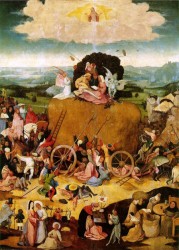
De Keyser 1939-40
“Rhetoricale toelichting bij het hooi en den hooiwagen” (P. De Keyser) 1939/40
[in: Gentsche Bijdragen tot de Kunstgeschiedenis, VI (1939/40), pp. 127-137]
[Also mentioned in Gibson 1983: 98 (E153)]
Our sixteenth-century painters en rederijkers [rhetoricians], uut jonsten versaemt [merrily gathered] in the same Guilds of St Lucas, used the same source for their subjects: the widely varied popular life of the sixteenth century. Moreover, the rhetoricians were very fond of witty riddles and rebuses, just like the painters.
De Keyser then signals a sixteenth-century edition: Ordinantie van de nieu Punten van onser Vrouwen Ommeganck half Oogst 1563 [Ordinance of the new ‘Punten’ of the Procession of Our Lady mid-August 1563] (Antwerp, Hans de Laet). This text describes the punten (floats with an allegorical representation) of the procession of Our Lady in Antwerp in 1563. One of these floats was a haywain. The edition also has a sixteenth-century song in the form of a refrein with the recurring line diet wel besiet / het is al niet [if you are on the alert / nothing, that’s what it is all worth]. The song is a moralizing complaint about the blind hunt for the ‘vain works of the World’ (verses 41-42) and for ‘earthly profits’ (verse 29), meaning: fame and money (verse 36). Fraud (verses 20-24) and folly (verse 33) set the tone in all this. Important regarding Bosch’s Haywain is the symbolical use of ‘hay’ and ‘haywain’ in this song. The haywain everybody (elck) wants to pick from, is equal to Weerelt (the World) and Eertsch gewin (Earthly profit). The grammatical parallellism between the line het is al niet [it is all nothing] and verse 17 (int eynde ist al Hoy = in the end it is all hay) points out the futility of all this.
Remarkable is the following. The original edition is said to have been in the Brussels Royal Library as number 277.814 of the Van Hulthem Catalogue. But this copy could not be found by De Keyser. He based himself on a transcript in the papers left by canon Dr. J. Bols (appointed as a member of the Royal Flemish Academy in 1887). According to a letter dated 24th December 1887 this canon had copied the text from an old book owned by his colleague P. Génard (appointed as a member of the Royal Flemish Academy in 1886).
De Keyser suggests that Bosch’s Haywain and the Frans Hogenberg etching are examples of a float from or for a procession. They serve a similar purpose: to convey a moral message to the spectators by means of new, common and yet unusual ideas.
[explicit]